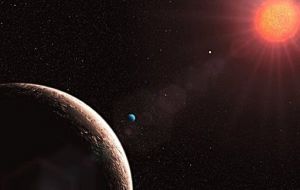MercoPress. South Atlantic News Agency
Earth like planet, Exoplanet E, discovered by Chile Observatory
 Gliese 581e (blue), the lightest exoplanet discovered so far
Gliese 581e (blue), the lightest exoplanet discovered so far The lightest and most earth-like planet ever discovered outside our solar system was identified this week using data from Chile’s La Silla observatory, said the European Organization for Astronomical Research in the Southern Hemisphere (ESO).
European researchers based in Geneva discovered the planet “E” in the Gliese 581 solar system after four years of observations from the La Silla observatory’s 3.6-meter ESO telescope and the HARPS spectrograph, the most successful small-planet-hunting tool in the world.
Lead researcher Michel Mayor, who discovered the first exoplanet ever in 1995, opened the conference announcing his team’s discoveries with the statement, “The holy grail of current exoplanet research is the detection of a rocky, Earth-like planet in the habitable zone.”
The newly discovered planet is roughly 1.9 times the mass of Earth and orbits its star in only 3.15 earth days. Built in 1969 by the ESO, the La Silla observatory is located in the southern Atacama Desert, roughly 600 kilometres north of Santiago, at an altitude of 2,400 meters. The clear skies and lack of light pollution makes the site ideal for astronomical observations.
Two years ago the ESO team also found that Gliese 581’s planet “D,” which orbits its star in the “habitable zone,” could have water on the surface of the planet. “[Planet] D could even be covered by a large and deep ocean — it is the first serious 'water world' candidate,” said researcher Stephane Udry.
Still, human habitation of a planet like “D” is not on the horizon. “D” is seven times the size of earth, so an 80-kilogram man on the planet would experience 560-kilograms worth of earth gravity, roughly the same as Mexico’s Manuel Uribe, the heaviest man on the Earth. The Gliese 581 system is located 20.5 light years from earth, or 100,000,000,000,000 kilometres.
The team was able to identify the presence of planets around Gliese 581 by making use of the Doppler Effect, the same phenomenon that causes ambulance sirens to change pitch as they drive past. Gravity from a planet orbiting a star pulls the star in very small circles that follow the planet’s orbit.
Researchers can detect changes in the “pitch” of the light coming from a star as it moves towards and away from a telescope in these small circles, and can use the data to determine the number, size, and distance of planets in a system.
“It is amazing to see how far we have come since we discovered the first exoplanet around a normal star in 1995 —the one around 51 Pegasi,” said Mayor. “The mass of Gliese 581 E is 80 times less than that of 51 Pegasi b. This is tremendous progress in just 14 years.”
By Chris Battey Santiago Times




Top Comments
Disclaimer & comment rulesCommenting for this story is now closed.
If you have a Facebook account, become a fan and comment on our Facebook Page!